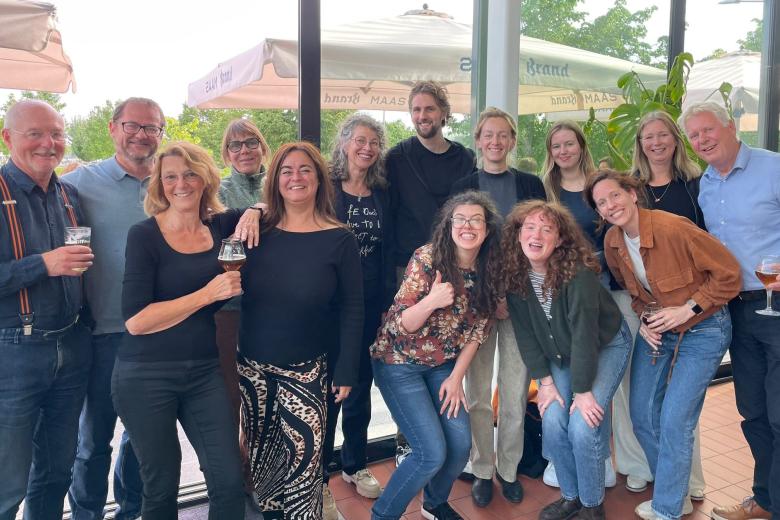Out of the brain, into control
Recently, Bettina Sorger received an NWO VIDI grant for her proposal entitled ‘Out of the brain, into control’ – Towards brain-based means of social and environmental interaction for children with severe cerebral palsy. As with most research, it all starts with a good idea. This time, prof. Jeroen Vermeulen (Chief Child Neurologist at MUMC+) gave the impetus. He mentioned to Bettina that some parents of children with severe cerebral palsy had never experienced a voluntary action or selection of their child due to the complete lack of motor control. “Jeroen asked me: ‘Bettina, can’t we do something for these children and their parents?’”. Sorger was touched and encouraged to work towards an idea for a potential way to help.
Cerebral Palsy
Cerebral palsy is a non-progressive motor disease, caused by brain damage before, during, or shortly after childbirth (e.g., through a temporary oxygen deficiency). The disease is non-progressive, meaning it won’t get worse, but it also won’t get better. The brain damage, mainly to the motor functioning, has a great impact on the development of the child. “Apart from sitting, walking and running, we need our motor system to interact with the environment and to communicate”. Cognitive abilities can be acquired without motor skills; For example, language comprehension might not be affected in these children. However, in the most severe case, cerebral palsy does not allow affected children to interact with their family or to make any voluntary movement. There is simply no control.
“This does not only mean that you cannot talk. You can’t even nod or shake your head to express yourselves. You have no way of communicating and interacting with your environment”. Not being able to communicate blocks your ability to show basic needs, wishes, interest, or even express your feelings. “This situation is not only difficult for the children, but also for their parents - eventually for everyone around them”.
“It’s is also hard to monitor the children’s cognitive development, because available tests involve at least some form of motor action. You have to press a button or say the answer, which is impossible for these children”.
An alternative way of interacting
“In my VIDI project, I want to try to circumvent the motor system and enable these children to interact and communicate”. A way to do this is to employ brain signals that the children are still able to voluntarily generate and that can be measured (‘read’) with neuroscientific methods. “We simply replace overt motor behaviour by (normally covert) ‘neural’ behaviour”. There has already been a lot of research into alternative brain-based communication/control means for so-called ‘locked-in’ patients. These (mostly older) patients also have no way of communicating naturally, e.g., due to a degenerative motor disease such as amyotrophic lateral sclerosis. “These patients still have a vivid and rich mental life. And they also need a way to share this with others”.
By using brain signals instead of overt motor actions, Sorger hopes to enable affected children to give at least “yes” and “no” answers to binary questions. “We really need to develop something straightforward and easy-to-use, that we can apply in everyday life”. At best, the parents themselves will be able to operate the alternative communication system.
Functional Near-Infrared Spectroscopy
Sorger will use Functional Near-Infrared Spectroscopy for measuring brain signals - a method that is up-and-coming in the world of neuroscience. It uses light to measure brain activity. “We send near-infrared light into the brain and the amount of light that is picked up by sensors depends on the level of de/-oxygenated haemoglobin in the blood. The oxygenation level is linked to the amount of neural activity that is evoked by the mental task. The benefits of this method are that you can measure in a natural environment, as often it is needed, and the technique is absolutely safe. Also, it is less sensitive to motion and less costly than other methods. “And luckily it is particularly well suited for children, as they have smaller heads and finer hair than adults which is beneficial for the signal quality!”
With this method, Sorger will not be able to read-out the children’s answers (“yes” and “no”) directly. However, she can differentiate whether someone is thinking about a particular physical action or is doing math. “If you think about drawing a picture, the evoked brain activation is different to the activation caused by doing a calculation task. So, what we can do is, for example, to let the children use motor imagery for answering “yes” and to perform calculations in their mind to say “No”.
“We have to see how far we come, but this could open up the door for more self-efficacy and self-determination of these kids”. Sorger is also thinking ahead, beyond simple “yes” and “no” answering of questions. Binary answers can also be implemented, for example, in gaming, where these choices can influence a real or virtual environment. “We want to give these kids the feeling that they can have an impact on the outside world. I have a 10-year-old daughter myself, and I can see the value of being able to be an active part of our world”.
“It is extremely difficult to get such a grant these days. Sure, it takes creativity and hard work, but also a considerable amount of luck. For the latter, I am very grateful and for Jeroen’s initial question that I would like to answer one day with a clear “Yes, we can!”
Also read
-
Most prestigious European grant to two UM scientists
Two Maastricht University professors are to receive the most prestigious European research grant for individual researchers: an ERC Advanced Grant, worth over €2.5 million. They are Lorenzo Moroni (MERLN) and Alexander Sack (FPN).

-
CIAO extends cooperation with UWV for four years
The Centre of Expertise for Inclusive Organisations (CIAO), under the banner of the Faculty of Psychology and Neuroscience at Maastricht University, has extended its successful cooperation with the UWV (Uitvoeringsinstituut Werknemersverzekeringen) for four years. We spoke to Gemma van Ruitenbeek...

-
Brain stimulation in people with neglect
Marij Middag (PhD Candidate) and Teresa Schuhmann (Professor of Clinical Applications of Non-invasive Brain Stimulation) from the Department of Cognitive Neuroscience at the Faculty of Psychology and Neuroscience, have recently published their paper Alpha transcranial alternating current stimulation...